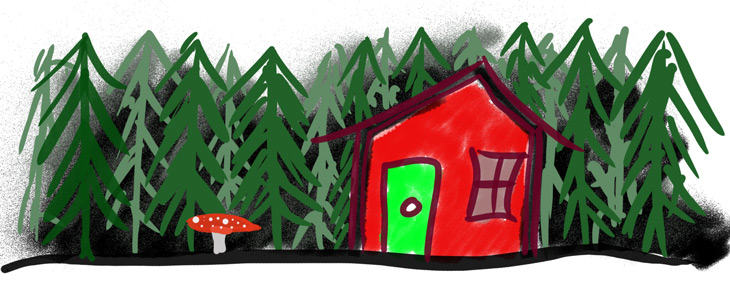Boreal Forests
The Taiga
The mysterious forests and treacherous quagmires of the far northern latitudes have inspired storytellers for centuries. The Nordic fables that we read as bedtime stories paint a vivid picture of the northern boreal forests. These are the kind of forests where a lost traveler could lay down on a thick bed of moss only to wake up and find himself surrounded by curious gnomes; where trolls guard bridges; where marsh-men are known to drag you into peat bogs and never let you go…
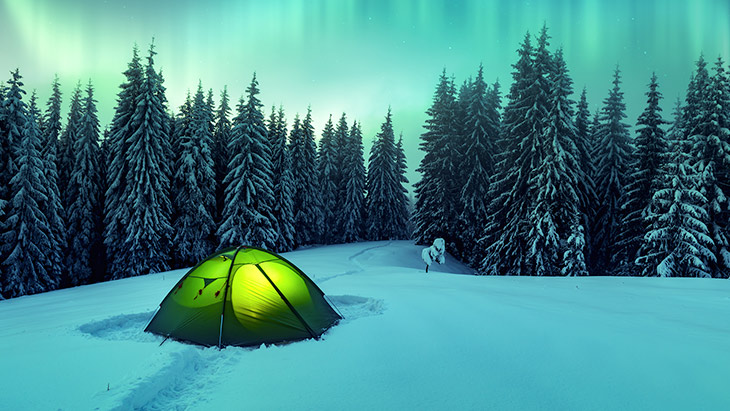
It’s no wonder people respected these forests and feared the creatures that may have lay in the shadows. Large mammals like moose, bears and wolves are commonly found here, and many people actually do get sucked into the bogs and marshes. Beyond these dangers, the forest itself is often dark and mysterious. Thick stands of Fir and Spruce trees create a canopy that blocks most of the sunlight, making it dark and difficult to navigate. Green and black lichens drape themselves from the tall trees like hag’s hair, playing tricks on your eyes, causing you to think very seriously about the existence of wood-goblins…
Wild fantasies and overactive imaginations aside, the boreal forest is the largest terrestrial biome on the planet, with much of it still undisturbed and unaltered by human beings. The bogs and marshes contain plant species with amazing adaptations for survival, and the forest can be truly enchanting, despite the lack of gingerbread-house-dwelling witches.
Where can we find them?
Boreal forests are only found in the northern hemisphere of Earth, mainly between latitudes 50° and 60° N. With short, cool summers and long, cold winters, these forests form an almost contiguous belt around the Earth, sandwiched between temperate deciduous forests to the south and tundra to the north.
Due to the short growing season in these regions, deciduous trees don’t have enough time to regrow their leaves, and very few of them are able to survive. Instead, coniferous trees dominate because they don’t have to regrow their leaves and are better adapted for a colder climate. South of the boreal forest, the growing season is longer, warmer, and better suited for deciduous trees, so temperate deciduous forests dominate. North of the boreal forest, temperatures stay cold enough to keep any trees from growing, and we call this region the tundra. Essentially, boreal forests occur in a “Goldilocks” zone, where temperatures are too cold for temperate forests and too warm to be considered tundra.
Abiotic Factors: Climate
As we have said, boreal forests are characterized by having a very short growing season in which plants only have about 50-100 frost-free days to grow. In these regions, winters can last over 6 months, with average temperatures generally staying around -20° C (-4° F). Summers are short and stay at about 50° F, but can get as high as 80° F in some areas. Precipitation rates are low (~15-20 inches annually) and fall mostly during the summer months. But in these regions, moisture tends to stick around for longer periods of time due to low temperatures and evaporation rates. Therefore, even though these regions receive as little precipitation as some deserts, they remain moist for most of the growing season!
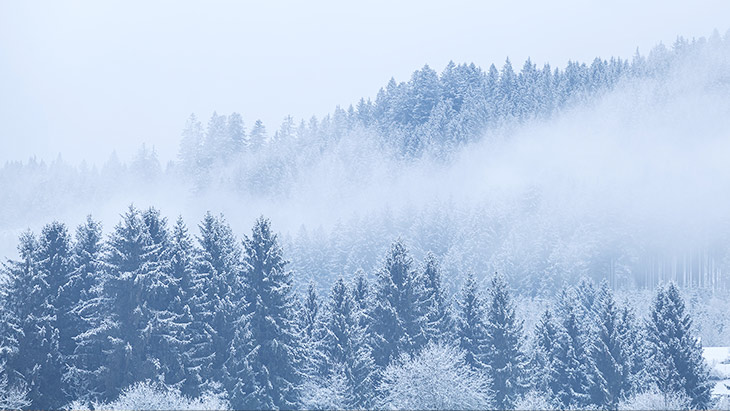
This peculiar, dry-but-moist climate is mainly influenced by the interaction of two air masses during the summer and winter. You can think of “air masses” as big bubbles in the atmosphere that move air and water from one region of the world to another. Those big bubbles of air retain the same temperature and moisture levels as the region where they were “made” and essentially transport weather. For example, air masses that were created in arctic regions tend to be cold (for obvious reasons) and dry, because water does not evaporate into the air as much in the Arctic. So, when the arctic air mass moves to another region, it brings cold, dry weather with it. During the summer in the boreal forest, warm, moist air from the Pacific air mass moves north, bringing warm weather and rain. During the winter, cold, dry air from the Arctic air mass pushes south, into the boreal forest, causing the cold, dry winters.
Snowy Boreal Forest
Interestingly, when temperatures start to drop in the fall, the snow that falls on the taiga actually helps to keep it warm! The thick snow drifts that accumulate in the forest insulate the ground below them like a thermos, allowing the soil temperatures to stay above freezing, while the air above them is well below it.
Abiotic Factors: Soil
One of the most important abiotic factors in any forest ecosystem is the condition of the soil. Factors like nutrient levels, moisture content, and decomposition rates determine what plants are able to grow there. The boreal forest soils are what soil scientists call spodosols and are considered to be very hostile soil conditions. The word “spodosol” comes from a Russian word meaning “under ash” and refers to a layer of gray, nutrient-poor soil beneath a thin layer of organic material. In soils like this, water leaches through the upper layer of sandy soil quickly, dragging almost all available nutrients with it. Then, the decomposed material (organic nutrients) and fine grained quartz (sand and clay) that leached through the soil are broken down and chemically altered to form a layer of gray, nutrient-poor clay.
Not only is the soil lacking vital nutrients for plant growth, but coniferous trees poison it to keep other plants from sprouting! The needles from coniferous trees in these forests contain a high concentration of resins, oils and other chemicals that can help prevent them from freezing solid in the winter. When they fall off the tree, though, all of those chemicals leach into the soil, making it very acidic and often toxic to other plants.
Finally, remember that evaporation does not happen very quickly in a boreal forest. The little precipitation that does fall in these forests accumulates in the soil, decreasing the amount of available oxygen and slowing the rate of decomposition. Put it all together and you get a poisonous, acidic soil that leaches the few nutrients it has available for plants to grow; harsh conditions indeed!
What do they look like?
Types of Taiga: Light and Dark
Like fine chocolate, boreal forests come in two flavors: light and dark. The dark taiga is commonly found in the southern range, where the climate and soil conditions are more favorable for plants and thick stands of Spruce and Hemlock create a closed canopy. The light taiga is found more often in regions where the soil is too nutrient-poor to support as many trees. In these areas, Pines and Larches are spread further apart and create an open canopy.
Oddly enough, the dark, dank, spooky forests described in Nordic fairy tales are actually more supportive of life than the bright, open pine forests of the light taiga. While both versions of the boreal forest have low biological diversity, the soils of the dark taiga tend to be more nutrient-rich and thus more supportive of plant life. In areas where light can penetrate the canopy, the herbaceous layer of the forest can be downright lush; filled with ferns, Fireweed, Shrub Alders, raspberries, salmonberries, blueberries, black currant, red currant… (It’s no wonder the bear poop here is filled with fruit seeds!) On the other hand, the light taiga has drier, more infertile soil and a more open understory.
Why are Boreal Forests so Coniferous?!
Conifers like Pine, Fir, Larch, Spruce, and Hemlock are are well adapted for harsh conditions and are the dominant trees species in the boreal forest. As opposed to deciduous trees, which lose their leaves as soon as it gets cold, conifers retain their needles throughout the winter. The dark green needles help to absorb heat and allow them to begin photosynthesis as soon as temperatures rise above freezing. Needles also help to prevent water loss because the stomatal openings (pores that exchange gas and water) are positioned on the underside of the needle, underneath a waxy cuticle.
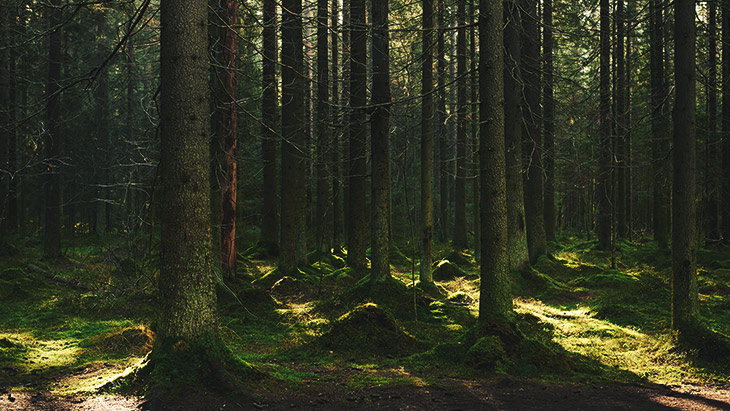
In the winter, when heavy snowfall accumulates, their conical shape helps to shed snow and prevents branches from breaking off. To combat temperatures well below freezing, conifers produce resins and other chemicals that act like antifreeze and keep the tree from freezing solid in the winter. When the needles fall off the tree, the chemicals that helped them resist freezing leach into the soil. This helps the tree outcompete other plants by creating a toxic environment in the soil, an adaptation called allelopathy.
Other Plant Adaptations
While conifers are the dominant tree species, some deciduous trees have found a foothold in the boreal forest, despite the cold, infertile conditions. Trees and shrubs of the genus Alnus (Alder) have bacteria-filled nodules in their roots which help to convert atmospheric nitrogen into useable nutrients, feeding not only themselves but the plants around them as well. Other deciduous trees like Willow and Aspen require a large amount of water to grow and can be found where soil moisture levels are too high for conifers.
Other plants have found ways to get the nutrients they need without having to gather much from the infertile soil. Sun Dew and Pitcher Plants are carnivorous plants that you may spot in the bogs and fens of the taiga. These plants get nutrients by trapping and digesting insects and other arthropods.
Ancient History and Succession
Given Earth’s loooong geologic history, our boreal forests are relative newcomers to the world biome scene. This is not to say coniferous forests like this haven’t existed before. They have. Just not where you would expect them to be. This is because throughout Earth’s climatic history, temperatures have fluctuated regularly, and glaciers have expanded and retracted over enormous distances. Approximately 20,000 years ago, when ice sheets were at their last glacial maximum, tundra and permafrost covered much of what is now boreal forest, and coniferous forests grew where we now see temperate deciduous forests. As the glaciers retreated, they literally paved the way for modern boreal forests.
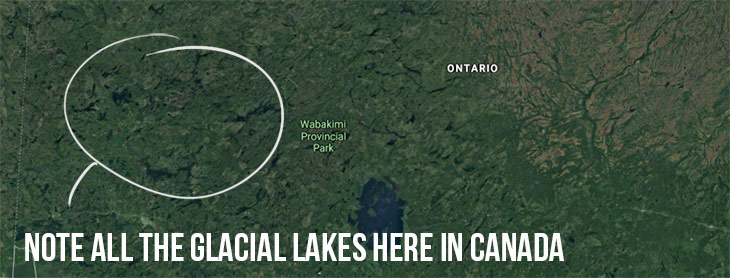
Glaciers, Lakes, and Bogs
As the glaciers retreated north, they scraped and gouged the Earth below them, leaving behind vast expanses of tundra and landscapes pockmarked with deep depressions. The tundra eventually gave way to coniferous forests when the temperatures were right, and the depressions filled with water, forming thousands and thousands of glacial lakes. In the northern latitudes, a unique moss called sphagnum moss helped to drastically change the landscape.
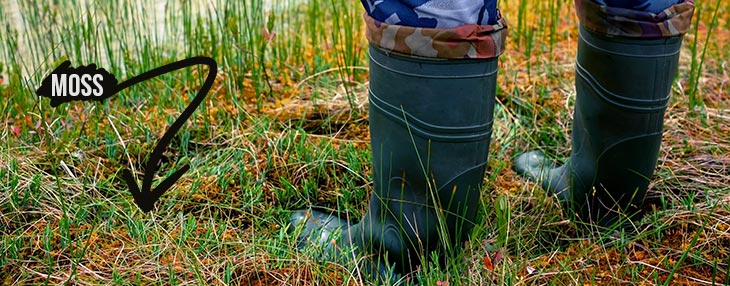
Sphagnum moss is crazy awesome, y’all. It is most often found along the edges of lakes and bogs, where it absorbs an unbelievable amount of water. (One ounce of dry sphagnum can hold almost a pound of water!) As more and more sphagnum builds up around the lake, some of it dies and begins to decompose. Remember that decomposition is a slow process in the Boreal forest, due to acidic and oxygen-poor conditions. When sphagnum decomposes under these conditions it turns into peat, a rich organic sediment, which accumulates around the lake’s edges and fills in from below. When enough sphagnum moss and peat have displaced the water in a lake, it can be called a bog. When the peat layers displace all of the water in the bog, trees are able to take root, and eventually, boreal forest takes the place of the bog. The eventual succession from bog to forest can take a very long time because the soil conditions in a bog are even more acidic and oxygen-starved than the boreal forest. Due to the extreme acidity and low oxygen conditions in a bog, they usually host a very unique set of plants which are adapted to the most extreme conditions. Cranberries, lingonberries, and dwarf blueberries are small, tart berries that do well in these conditions, and can be a sweet treat for a bog-traveler, if they don’t get pulled down by subterranean marsh kings first!
Actually, marsh kings don’t really exist (as far as we know), but bogs can be dangerous places to wander if you aren’t careful. The real reason is the peat layers at the bottom of a bog can be deceptively deep. If you stepped in an area where the peat was not fully compact, you could end up sinking up to your waist, or deeper, and be unable to climb out.
Common Disturbances
Boreal forests are not as long lived as many old-growth deciduous forests. While many stands of boreal forest can reach a mature age, frequent disturbances often keep the forest from reaching late successional stages. Insects are one of the most common disturbances that keep these forests from getting too old. In North America, for example, Spruce Bark Beetles are responsible for killing millions of mature Spruce trees every year. The beetles dig their way in between the bark and wood of the tree, eating away the cambium layer. Eventually, the tree is unable to transport its nutrients and it dies. While the beetle attacks both young and old trees, young trees are able to defend themselves more readily than mature trees, and are less affected by beetle infestations. While beetle infestations are a natural component of the boreal forest, global climate change has allowed them to speed up their life cycle, and damage from beetle attacks has escalated as a result.
Fire is another common disturbance in the dry areas of a boreal forest. In this case, mature trees normally survive the blaze, but young trees and ground cover burn quickly, recycling their nutrients back into the soil. Working in tandem, these disturbances keep the forest young and healthy.
Find out more at The Wild Classroom!
Related Topics
The Taiga
The mysterious forests and treacherous quagmires of the far northern latitudes have inspired storytellers for centuries. The Nordic fables that we read as bedtime stories paint a vivid picture of the northern boreal forests. These are the kind of forests where a lost traveler could lay down on a thick bed of moss only to wake up and find himself surrounded by curious gnomes; where trolls guard bridges; where marsh-men are known to drag you into peat bogs and never let you go…

It’s no wonder people respected these forests and feared the creatures that may have lay in the shadows. Large mammals like moose, bears and wolves are commonly found here, and many people actually do get sucked into the bogs and marshes. Beyond these dangers, the forest itself is often dark and mysterious. Thick stands of Fir and Spruce trees create a canopy that blocks most of the sunlight, making it dark and difficult to navigate. Green and black lichens drape themselves from the tall trees like hag’s hair, playing tricks on your eyes, causing you to think very seriously about the existence of wood-goblins…
Wild fantasies and overactive imaginations aside, the boreal forest is the largest terrestrial biome on the planet, with much of it still undisturbed and unaltered by human beings. The bogs and marshes contain plant species with amazing adaptations for survival, and the forest can be truly enchanting, despite the lack of gingerbread-house-dwelling witches.
Where can we find them?
Boreal forests are only found in the northern hemisphere of Earth, mainly between latitudes 50° and 60° N. With short, cool summers and long, cold winters, these forests form an almost contiguous belt around the Earth, sandwiched between temperate deciduous forests to the south and tundra to the north.
Due to the short growing season in these regions, deciduous trees don’t have enough time to regrow their leaves, and very few of them are able to survive. Instead, coniferous trees dominate because they don’t have to regrow their leaves and are better adapted for a colder climate. South of the boreal forest, the growing season is longer, warmer, and better suited for deciduous trees, so temperate deciduous forests dominate. North of the boreal forest, temperatures stay cold enough to keep any trees from growing, and we call this region the tundra. Essentially, boreal forests occur in a “Goldilocks” zone, where temperatures are too cold for temperate forests and too warm to be considered tundra.
Abiotic Factors: Climate
As we have said, boreal forests are characterized by having a very short growing season in which plants only have about 50-100 frost-free days to grow. In these regions, winters can last over 6 months, with average temperatures generally staying around -20° C (-4° F). Summers are short and stay at about 50° F, but can get as high as 80° F in some areas. Precipitation rates are low (~15-20 inches annually) and fall mostly during the summer months. But in these regions, moisture tends to stick around for longer periods of time due to low temperatures and evaporation rates. Therefore, even though these regions receive as little precipitation as some deserts, they remain moist for most of the growing season!

This peculiar, dry-but-moist climate is mainly influenced by the interaction of two air masses during the summer and winter. You can think of “air masses” as big bubbles in the atmosphere that move air and water from one region of the world to another. Those big bubbles of air retain the same temperature and moisture levels as the region where they were “made” and essentially transport weather. For example, air masses that were created in arctic regions tend to be cold (for obvious reasons) and dry, because water does not evaporate into the air as much in the Arctic. So, when the arctic air mass moves to another region, it brings cold, dry weather with it. During the summer in the boreal forest, warm, moist air from the Pacific air mass moves north, bringing warm weather and rain. During the winter, cold, dry air from the Arctic air mass pushes south, into the boreal forest, causing the cold, dry winters.
Snowy Boreal Forest
Interestingly, when temperatures start to drop in the fall, the snow that falls on the taiga actually helps to keep it warm! The thick snow drifts that accumulate in the forest insulate the ground below them like a thermos, allowing the soil temperatures to stay above freezing, while the air above them is well below it.
Abiotic Factors: Soil
One of the most important abiotic factors in any forest ecosystem is the condition of the soil. Factors like nutrient levels, moisture content, and decomposition rates determine what plants are able to grow there. The boreal forest soils are what soil scientists call spodosols and are considered to be very hostile soil conditions. The word “spodosol” comes from a Russian word meaning “under ash” and refers to a layer of gray, nutrient-poor soil beneath a thin layer of organic material. In soils like this, water leaches through the upper layer of sandy soil quickly, dragging almost all available nutrients with it. Then, the decomposed material (organic nutrients) and fine grained quartz (sand and clay) that leached through the soil are broken down and chemically altered to form a layer of gray, nutrient-poor clay.
Not only is the soil lacking vital nutrients for plant growth, but coniferous trees poison it to keep other plants from sprouting! The needles from coniferous trees in these forests contain a high concentration of resins, oils and other chemicals that can help prevent them from freezing solid in the winter. When they fall off the tree, though, all of those chemicals leach into the soil, making it very acidic and often toxic to other plants.
Finally, remember that evaporation does not happen very quickly in a boreal forest. The little precipitation that does fall in these forests accumulates in the soil, decreasing the amount of available oxygen and slowing the rate of decomposition. Put it all together and you get a poisonous, acidic soil that leaches the few nutrients it has available for plants to grow; harsh conditions indeed!
What do they look like?
Types of Taiga: Light and Dark
Like fine chocolate, boreal forests come in two flavors: light and dark. The dark taiga is commonly found in the southern range, where the climate and soil conditions are more favorable for plants and thick stands of Spruce and Hemlock create a closed canopy. The light taiga is found more often in regions where the soil is too nutrient-poor to support as many trees. In these areas, Pines and Larches are spread further apart and create an open canopy.
Oddly enough, the dark, dank, spooky forests described in Nordic fairy tales are actually more supportive of life than the bright, open pine forests of the light taiga. While both versions of the boreal forest have low biological diversity, the soils of the dark taiga tend to be more nutrient-rich and thus more supportive of plant life. In areas where light can penetrate the canopy, the herbaceous layer of the forest can be downright lush; filled with ferns, Fireweed, Shrub Alders, raspberries, salmonberries, blueberries, black currant, red currant… (It’s no wonder the bear poop here is filled with fruit seeds!) On the other hand, the light taiga has drier, more infertile soil and a more open understory.
Why are Boreal Forests so Coniferous?!
Conifers like Pine, Fir, Larch, Spruce, and Hemlock are are well adapted for harsh conditions and are the dominant trees species in the boreal forest. As opposed to deciduous trees, which lose their leaves as soon as it gets cold, conifers retain their needles throughout the winter. The dark green needles help to absorb heat and allow them to begin photosynthesis as soon as temperatures rise above freezing. Needles also help to prevent water loss because the stomatal openings (pores that exchange gas and water) are positioned on the underside of the needle, underneath a waxy cuticle.

In the winter, when heavy snowfall accumulates, their conical shape helps to shed snow and prevents branches from breaking off. To combat temperatures well below freezing, conifers produce resins and other chemicals that act like antifreeze and keep the tree from freezing solid in the winter. When the needles fall off the tree, the chemicals that helped them resist freezing leach into the soil. This helps the tree outcompete other plants by creating a toxic environment in the soil, an adaptation called allelopathy.
Other Plant Adaptations
While conifers are the dominant tree species, some deciduous trees have found a foothold in the boreal forest, despite the cold, infertile conditions. Trees and shrubs of the genus Alnus (Alder) have bacteria-filled nodules in their roots which help to convert atmospheric nitrogen into useable nutrients, feeding not only themselves but the plants around them as well. Other deciduous trees like Willow and Aspen require a large amount of water to grow and can be found where soil moisture levels are too high for conifers.
Other plants have found ways to get the nutrients they need without having to gather much from the infertile soil. Sun Dew and Pitcher Plants are carnivorous plants that you may spot in the bogs and fens of the taiga. These plants get nutrients by trapping and digesting insects and other arthropods.
Ancient History and Succession
Given Earth’s loooong geologic history, our boreal forests are relative newcomers to the world biome scene. This is not to say coniferous forests like this haven’t existed before. They have. Just not where you would expect them to be. This is because throughout Earth’s climatic history, temperatures have fluctuated regularly, and glaciers have expanded and retracted over enormous distances. Approximately 20,000 years ago, when ice sheets were at their last glacial maximum, tundra and permafrost covered much of what is now boreal forest, and coniferous forests grew where we now see temperate deciduous forests. As the glaciers retreated, they literally paved the way for modern boreal forests.

Glaciers, Lakes, and Bogs
As the glaciers retreated north, they scraped and gouged the Earth below them, leaving behind vast expanses of tundra and landscapes pockmarked with deep depressions. The tundra eventually gave way to coniferous forests when the temperatures were right, and the depressions filled with water, forming thousands and thousands of glacial lakes. In the northern latitudes, a unique moss called sphagnum moss helped to drastically change the landscape.

Sphagnum moss is crazy awesome, y’all. It is most often found along the edges of lakes and bogs, where it absorbs an unbelievable amount of water. (One ounce of dry sphagnum can hold almost a pound of water!) As more and more sphagnum builds up around the lake, some of it dies and begins to decompose. Remember that decomposition is a slow process in the Boreal forest, due to acidic and oxygen-poor conditions. When sphagnum decomposes under these conditions it turns into peat, a rich organic sediment, which accumulates around the lake’s edges and fills in from below. When enough sphagnum moss and peat have displaced the water in a lake, it can be called a bog. When the peat layers displace all of the water in the bog, trees are able to take root, and eventually, boreal forest takes the place of the bog. The eventual succession from bog to forest can take a very long time because the soil conditions in a bog are even more acidic and oxygen-starved than the boreal forest. Due to the extreme acidity and low oxygen conditions in a bog, they usually host a very unique set of plants which are adapted to the most extreme conditions. Cranberries, lingonberries, and dwarf blueberries are small, tart berries that do well in these conditions, and can be a sweet treat for a bog-traveler, if they don’t get pulled down by subterranean marsh kings first!
Actually, marsh kings don’t really exist (as far as we know), but bogs can be dangerous places to wander if you aren’t careful. The real reason is the peat layers at the bottom of a bog can be deceptively deep. If you stepped in an area where the peat was not fully compact, you could end up sinking up to your waist, or deeper, and be unable to climb out.
Common Disturbances
Boreal forests are not as long lived as many old-growth deciduous forests. While many stands of boreal forest can reach a mature age, frequent disturbances often keep the forest from reaching late successional stages. Insects are one of the most common disturbances that keep these forests from getting too old. In North America, for example, Spruce Bark Beetles are responsible for killing millions of mature Spruce trees every year. The beetles dig their way in between the bark and wood of the tree, eating away the cambium layer. Eventually, the tree is unable to transport its nutrients and it dies. While the beetle attacks both young and old trees, young trees are able to defend themselves more readily than mature trees, and are less affected by beetle infestations. While beetle infestations are a natural component of the boreal forest, global climate change has allowed them to speed up their life cycle, and damage from beetle attacks has escalated as a result.
Fire is another common disturbance in the dry areas of a boreal forest. In this case, mature trees normally survive the blaze, but young trees and ground cover burn quickly, recycling their nutrients back into the soil. Working in tandem, these disturbances keep the forest young and healthy.
Find out more at The Wild Classroom!

